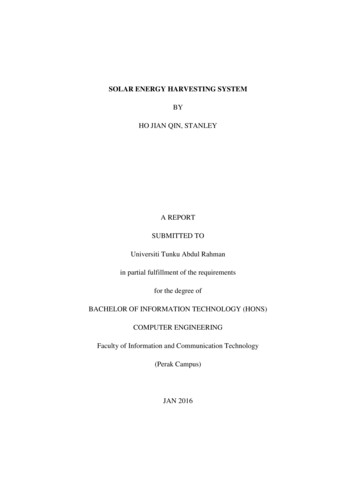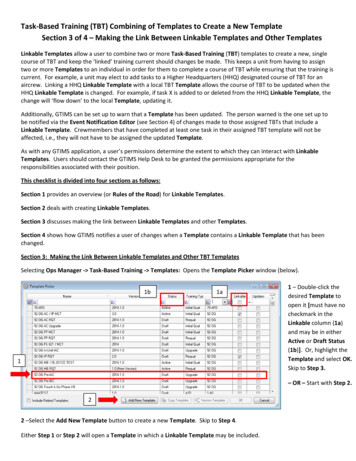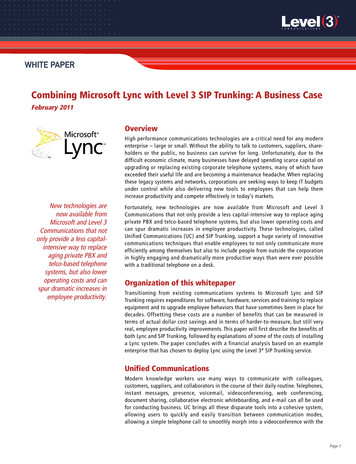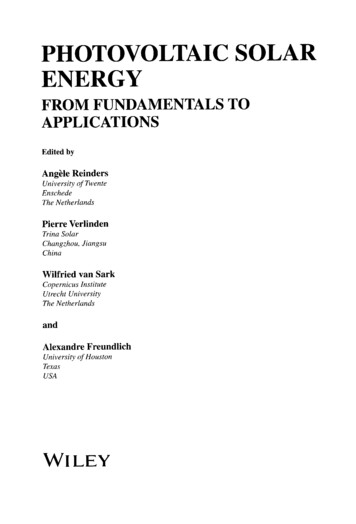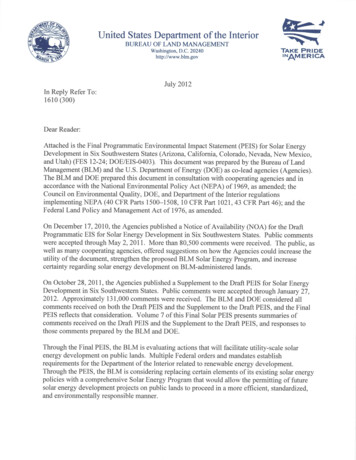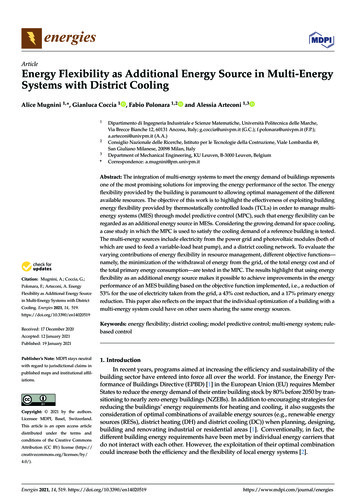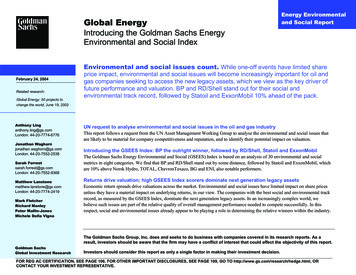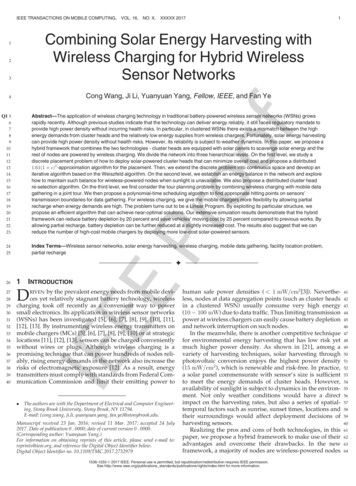
Transcription
IEEE TRANSACTIONS ON MOBILE COMPUTING,VOL. 16,NO. X,XXXXX 20171Combining Solar Energy Harvesting withWireless Charging for Hybrid WirelessSensor Networks123Cong Wang, Ji Li, Yuanyuan Yang, Fellow, IEEE, and Fan Ye4Q1 5Abstract—The application of wireless charging technology in traditional battery-powered wireless sensor networks (WSNs) growsrapidly recently. Although previous studies indicate that the technology can deliver energy reliably, it still faces regulatory mandate toprovide high power density without incurring health risks. In particular, in clustered WSNs there exists a mismatch between the highenergy demands from cluster heads and the relatively low energy supplies from wireless chargers. Fortunately, solar energy harvestingcan provide high power density without health risks. However, its reliability is subject to weather dynamics. In this paper, we propose ahybrid framework that combines the two technologies - cluster heads are equipped with solar panels to scavenge solar energy and therest of nodes are powered by wireless charging. We divide the network into three hierarchical levels. On the first level, we study adiscrete placement problem of how to deploy solar-powered cluster heads that can minimize overall cost and propose a distributed1:61ð1 þ Þ2 -approximation algorithm for the placement. Then, we extend the discrete problem into continuous space and develop aniterative algorithm based on the Weiszfeld algorithm. On the second level, we establish an energy balance in the network and explorehow to maintain such balance for wireless-powered nodes when sunlight is unavailable. We also propose a distributed cluster headre-selection algorithm. On the third level, we first consider the tour planning problem by combining wireless charging with mobile datagathering in a joint tour. We then propose a polynomial-time scheduling algorithm to find appropriate hitting points on sensors’transmission boundaries for data gathering. For wireless charging, we give the mobile chargers more flexibility by allowing partialrecharge when energy demands are high. The problem turns out to be a Linear Program. By exploiting its particular structure, wepropose an efficient algorithm that can achieve near-optimal solutions. Our extensive simulation results demonstrate that the hybridframework can reduce battery depletion by 20 percent and save vehicles’ moving cost by 25 percent compared to previous works. Byallowing partial recharge, battery depletion can be further reduced at a slightly increased cost. The results also suggest that we canreduce the number of high-cost mobile chargers by deploying more low-cost solar-powered x Terms—Wireless sensor networks, solar energy harvesting, wireless charging, mobile data gathering, facility location problem,partial CTIONDby the prevalent energy needs from mobile devices yet relatively stagnant battery technology, wirelesscharging took off recently as a convenient way to powersmall electronics. Its application in wireless sensor networks(WSNs) has been investigated [5], [6], [7], [8], [9], [10], [11],[12], [13]. By instrumenting wireless energy transmitters onmobile chargers (MCs) [5], [6], [7], [8], [9], [10] or at strategiclocations [11], [12], [13], sensors can be charged convenientlywithout wires or plugs. Although wireless charging is apromising technique that can power hundreds of nodes reliably, rising energy demands in the network also increase therisks of electromagnetic exposure [12]. As a result, energytransmitters must comply with standards from Federal Communication Commission and limit their emitting power toRIVENIEE26 The authors are with the Department of Electrical and Computer Engineering, Stony Brook University, Stony Brook, NY 11794.E-mail: {cong.wang, ji.li, yuanyuan.yang, fan.ye}@stonybrook.edu.Manuscript received 23 Jan. 2016; revised 11 Mar. 2017; accepted 24 July2017. Date of publication 0 . 0000; date of current version 0 . 0000.(Corresponding author: Yuanyuan Yang.)For information on obtaining reprints of this article, please send e-mail to:reprints@ieee.org, and reference the Digital Object Identifier below.Digital Object Identifier no. 10.1109/TMC.2017.2732979human safe power densities ( 1 mW cm2 [3]). Nevertheless, nodes at data aggregation points (such as cluster headsin a clustered WSN) usually consume very high energy(10 100 mW) due to data traffic. Thus limiting transmissionpower at wireless chargers can easily cause battery depletionand network interruption on such nodes.In the meanwhile, there is another competitive techniquefor environmental energy harvesting that has low risk yetmuch higher power density. As shown in [21], among avariety of harvesting techniques, solar harvesting throughphotovoltaic conversion enjoys the highest power density(15 mW cm2 ), which is renewable and risk-free. In practice,a solar panel commensurate with sensor’s size is sufficientto meet the energy demands of cluster heads. However,availability of sunlight is subject to dynamics in the environment. Not only weather conditions would have a directimpact on the harvesting rates, but also a series of spatialtemporal factors such as sunrise, sunset times, locations andtheir surroundings would affect deployment decisions ofharvesting sensors.Realizing the pros and cons of both technologies, in thispaper, we propose a hybrid framework to make use of theiradvantages and overcome their drawbacks. In the newframework, a majority of nodes are wireless-powered nodes1536-1233 ß 2017 IEEE. Personal use is permitted, but republication/redistribution requires IEEE permission.See http://www.ieee.org/publications standards/publications/rights/index.html for more 6061626364
8VOL. 16,NO. X,XXXXX 2017reducing energy consumption. Fourth, we give a routeimprovement algorithm that saves an extra 25 percent moving energy on MCs and surpasses the algorithm in [40] byadditional 5 percent. The algorithm can also be used in a general setting for the Traveling Salesmen Problem with Neighborhood (TSPN) and provide solutions very close to theexact solutions found by exhaustive search. We also giveMCs more flexibility to only partially refill the battery in caseof high energy demand and propose an efficient algorithmthat yields solutions within 5 percent to optimality. Finally,we conduct extensive simulations to evaluate the performance of the framework compared to WSNs that are solelywireless-powered [5], [6], [7], [8], [9], [10], [11], [12], [13].The rest of the paper is organized as follows. Section 2conducts a literature review of the related works. Section 3presents the network model and assumptions. Section 4studies the placement problem of SNs. Section 5 providestheoretical analysis and discusses how to maintain energybalance using WNs. Section 6 optimizes MC’s migrationroutes and explores partial recharge for further improvements. Section 7 evaluates the new framework and Section 9concludes the paper.ro67(WNs) due to the low costs of charging coils. On the otherhand, due to the relatively higher manufacturing anddeploying costs, a small number of solar-powered nodes(SNs) are responsible for aggregating data. Normally, a fleetof MCs roam over the field to serve recharge requests fromWNs and collect data from SNs. In contrast to WNs, SNs’energy from the ambient source is self-sufficient. Thisscheme provides effective energy replenishment at clusterheads so that they can complete high volume data transmissions. Meanwhile, the rest of WNs can be recharged by MCson demand. The hybrid framework raises several new challenges. First, how many SNs are needed and where shouldwe deploy them such that the total cost is minimized? Second, how to guarantee robustness of the network when sunlight is unavailable (e.g., cloudy/raining days)? Third, howto schedule the MCs to complete wireless charging and datagathering in the same tour? Can we further optimize systemcost and improve network performance compared to previous approaches?To answer these questions, in this paper we first study aplacement problem in discrete form where SNs are deployedamong the known WN locations. We formulate it into a facility location problem [26], [27], [28], [29] to minimize the totalcost of packet routing and node deployment. Due to its NPhardness, we use the primal-dual method to develop a distributed 1:61ð1 þ Þ2 -factor algorithm suitable for WSNapplications based on the centralized paradigm in [28]. Thenwe show the locations of SNs can be further optimizedwithin a cluster in continuous space and propose an iterativemechanism based on the Weiszfeld algorithm [30]. We alsodemonstrate how our algorithms can adapt to seasonal variations of sunlight by adjusting their locations accordingly.Second, we theoretically analyze network energy balanceand propose a method to maintain such balance duringcloudy/raining days. We find that using a smaller clustersize is effective to reduce energy consumptions and developa distributed algorithm to appoint some selected WNs astemporary cluster heads until solar energy becomes available. Finally, we optimize MCs’ routes for the joint wirelesscharging and mobile data gathering problem. Different from[5] in which MCs visit exact node locations, we point out thatfor data gathering, it is only necessary for MCs to move intoSN’s transmission range. Based on this observation, we givea polynomial-time route improvement algorithm that cantake shortcuts through SN’s neighborhood to further reducethe cost. Since some nodes may require expedited rechargedue to limited lifetime, we allow the MCs to perform partialrecharge rather than to refill batteries to full capacity [5], [6],[7], [8], [9], [10]. Our objective is to simultaneously maximizethe time MCs spend in recharging and prevent nodes fromenergy depletion, which is formulated into a Linear Programming problem. For easy implementation on MCs, wepropose an efficient algorithm based on the particular structure of the lifetime constraints and validate its near-optimality by extensive simulations.The contribution of this paper is multi-fold. First, we propose a hybrid framework to overcome the constraints ofwireless charging and environmental harvesting techniques.To the best of our knowledge, this is the first work dealingwith WSNs using such hybrid energy sources. Second, weformulate the SN placement problem into a facility locationproblem and propose the first distributed 1:61ð1 þ Þ2 -factorapproximation algorithm for sensor applications. Third, wepropose a method to maintain network robustness by2RELATED WORKS2.1 Wireless ChargingWireless charging technology has developed at an unprecedented pace recently [1], [2] and its application has beenconsidered in battery-powered WSNs [5], [6], [7], [8], [9],[10], [11], [12], [13]. In [5], optimization of wireless chargingand mobile data gathering is studied by combining the twoutilities on a single MC. Based on the products from Powercast [4], wireless charging is explored in [6] to evaluate thenew impact on deployment patterns and packet routing.In [7], an Oðk2 k!Þ greedy algorithm (where k is the numberof nodes) is developed to maximize network lifetimewhereas the moving cost of wireless chargers is not considered. Upon realizing this problem, minimization ofchargers’ moving cost is considered in [8], [9]. In [8], a distributed real-time energy information gathering protocol isproposed first. Then based on the updated energy information, a weighted-sum algorithm considering nodes’ lifetimes and MCs’ moving costs is developed. The problem isfurther extended to jointly consider MCs’ recharge capacities and sensors’ dynamic battery deadlines in [9]. In [10], ajoint routing and wireless charging scheme is proposed toimprove network utilization and prolong network lifetime.Similarly, in [11], deployment problems of wireless chargersare studied to extend network lifetime.However, since many wireless charging systems are radiation-based, exposure to radio-frequency energy impliespotential health risks. The negative biological effects includeincreased possibility of tumor and other impairments.Therefore, the regulation limits the maximum transmitteroutput power to be under 1 W [3]. In practice, the omnidirectional propagation of electromagnetic wave causeshealth risks in all directions. Due to regulations of emittingpower level on a single charger, multiple wireless chargersare considered in [12], [13]. In [12], the problem of how toadjust the transmitting power of wireless chargers such thatoverall electromagnetic exposure does not exceed a threshold is studied. A charger placement problem is formulatedto guarantee all the locations to satisfy the safety requirements. In [13], optimization of “useful” energy transferredEP66IEE65IEEE TRANSACTIONS ON MOBILE 4175176177178179180181182183184185186187188189190
WANG ET AL.: COMBINING SOLAR ENERGY HARVESTING WITH WIRELESS CHARGING FOR HYBRID WIRELESS SENSOR 422432442452462472482492502512.2 Environmental Energy HarvestingEnvironmental energy harvesting provides another alternative to extend network lifespan. Renewable energy from theenvironment such as solar, wind, vibration and thermal canbe used effectively to power sensor nodes. Due to thedynamics in environmental energy sources, a majority ofprevious efforts focus on energy management of sensors[14], [15], [16], [17]. In [14], a power management scheme tomaximize sensors’ duty cycles is proposed. Energy is profiled based on moving average to predict future income andthe duty cycles are adjusted accordingly. In [15], the problemof maximizing quality of coverage is investigated for solarpowered WSNs. A nonlinear optimal control algorithm isproposed to dynamically allocate solar energy during theday and preserve energy for the night. Harvesting energyfrom light sources indoors is investigated in [16]. Energyallocation algorithms based on experimental measurementsare developed to optimize energy storage on sensors. Jointenergy management and resource allocation is considered in[17] for optimizing network performance. However, an inevitable drawback of these earlier works is that the networkoperations would be disrupted when those ambient energysources are unavailable (e.g,. during cloudy/raining days ina solar harvesting network). In contrast, our proposed framework in this paper incorporates a combination of hybridenergy sources so that steady and productive network performance can be guaranteed.Fig. 1. Overview of a three-level network hierarchy.of194incorporate both WNs and SNs in our framework. Therefore, we focus on how to minimize tour lengths by takingadvantage of SNs’ neighborhoods in a joint wireless charging and data gathering tour.3NETWORK MODEL AND ASSUMPTIONSro193from chargers to nodes under safety concerns is considered.However, since the accumulative emitting power from multiple chargers is still restricted, nodes cannot performenergy-consuming applications.In this section, we give an overview of the network modeland assumptions of the new framework. Based on theenergy sources, there are two types of nodes in the framework: wireless-powered nodes and solar-powered nodes.For brevity, we denote them by “WNs” and “SNs” respectively. Based on the functionality of network components,we divide the network into three hierarchical levels asshown in Fig. 1: wireless-powered sensor, solar-poweredsensor and mobile charger levels.The bottom level (wireless-powered sensor level) has NWNs uniformly randomly distributed on a square field ofside length L. Since charging coils can be cheaply manufactured, WNs are deployed in high density to perform basicsensing missions such as environmental readings, targettracking, etc. In particular, to monitor location-dependentsolar radiation strength, each node has an illuminance sensor and reports its reading with other data to the base station. The energy consumption for transmitting a packetfollows the widely adopted model [23], et ¼ e0 þ e1 dar ,where et is the transmitting energy, e0 and e1 are the energyconsumed in electronics and amplifiers, dr is the distancebetween the transmitter and the receiver (dr r, r is thetransmission range), and a is the path loss exponent. To perform sensing tasks, sensors also consume es energy for eachpacket. For message exchange, we assume the network isconnected. We also assume an event-driven data generationmodel [22]. Each WN generates packets independently following a Poisson process with average rate . Each WN ispowered by a 780 mAh rechargeable NiMH battery and therecharge time Tr is 78 minutes [24]. If the energy dropsbelow a threshold, e.g., 50 percent, it sends out a request tothe MCs for scheduling energy replenishment.The middle level (solar-powered sensor level) is comprised of self-sustaining, energy harvesting nodes. Normally, when solar energy income is sufficient, SNs act ascluster heads for aggregating sensed data. However, whenenergy supply is not enough during cloudy/raining days,the network re-selects WNs as cluster heads so they can relyon consistent wireless energy supply from the MCs. To minimize routing and deploying costs, SNs should be deployedat advantageous locations. Due to varying nature of sun’sangles during a year, building obstructions and tree shadesEP1922.3 Tour Planning of Mobile VehiclesTour planning of mobile vehicles for data collection inWSNs has been studied, see, for example in [18], [19], [20].The problem shares similarities to the well-known Traveling Salesmen Problem with Neighborhood [37], [38], [40] inwhich the salesman aims to find the shortest tour throughcity neighborhoods of arbitrary shapes. In the context ofWSNs, due to the omnidirectional propagation of electromagnetic waves, the neighborhoods are usually assumed tobe circles. In [18], the tour planning problem is formulatedinto a mixed-integer program and a spanning tree coveringalgorithm is proposed. However, the algorithm requires thevehicles to visit exact node locations for data gathering,which is usually unnecessary in practice. If the node’s transmission range is considered, the performance can be furtherimproved. The method proposed in [19] attempts toimprove current solutions for TSPN. It first determines theshortest TSP routes among sensors without consideringtheir transmission ranges. Then it searches along transmission boundaries to find the best hitting points such that thetour length is minimized. In [20], a progressive tour construction method is proposed. It exploits the overlaps oftransmission ranges of neighboring nodes so that the mobilevehicle can take shortcuts for cost savings. This methodworks effectively when there exist overlaps among nodes’transmission ranges. Different from [20] where nodes’ transmission ranges may have overlaps, in this paper, multi-hopclusters are formed such that one-hop transmission neighborhoods of cluster heads (SNs) are disjoint. In addition,different from all the previous works, a migration tour 8
IEEE TRANSACTIONS ON MOBILE COMPUTING,TABLE 1List of NotationsNotationNsmLret ; er ; es ps ; 333334335336337338339340341XXXXX 2017relat
IEEE Proof 65 (WNs) due to the low costs of charging coils. On the other 66 hand, due to the relatively higher manufacturing and 67 deploying costs, a small number of solar-powered nodes 68 (SNs) are responsible for aggregating data. Normally, a fleet 69 of MCs roam over the field to serve recharge requests from 7
